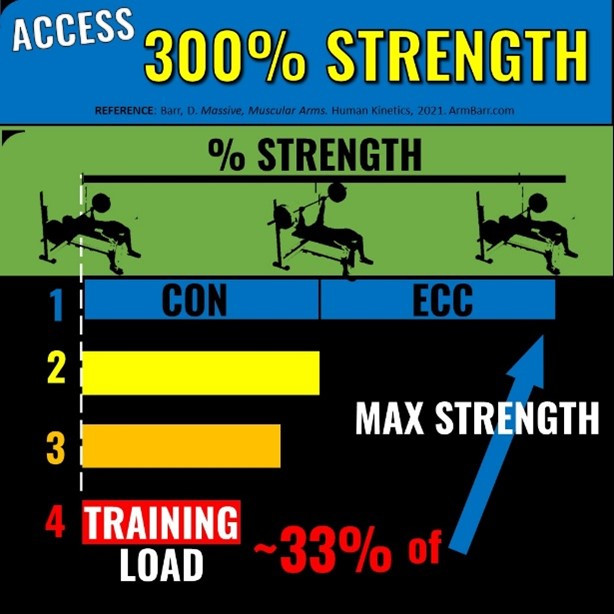Strength And Conditioning
Welcome and thanks for visiting...

Access 300 Percent Strength Now

It sounds hyperbolic, doesn't it? But there’s no trick, like ‘tapping a hidden light inside of you’ or other such woo -we’re just talking about untapped physiology here. I’ll show you how to upgrade your training to access 300% of the strength you’re using right now.
To build a better body, and subsequently improve performance, we’ll upgrade the fundamental component of lifting; the rep. Let’s take a cue from Elon Musk to break down training and build it up again, using the First Principles approach (aka reverse engineering).
Reminder: The forces, exerted on and by the muscle, dictate your subsequent strength gain and muscle growth (i.e. magnitude of the adaptive response). This means that accessing your eccentric force potential provides a stronger training stimulus and subsequent increases in strength and growth.
SideBarr: How You’ve been Conned with Training

Have you been conned?
If the above statement is patently absurd to you, then in the name of specificity, at least some eccentric training should be used. If you’re interested in other benefits, like muscle mass, strength, and injury prevention, you have further reason to break the bonds of gravity-limited concentric loading.
Key Point: We exert less force during our eccentric reps, in contrast to what 96% of us believe. This essential concept, and its application, is discussed in the article entitled Shocking Training Fix for More Size and Strength
The Anatomy of a Rep
It’s not immediately obvious that our training is concentric-only, so Figure 1. and the subsequent walkthrough illustrate just how truly limiting this is for us.

Figure 1. The Training Con. An illustration of the relative impact of Concentric Constraints that limit your training and subsequent results (discussed below).
1 Maximal Strength – The maximal amount of force you’re able to produce.
We traditionally think of peak strength being defined by the 1 Rep Max, but that measure doesn’t come close to our (untapped) eccentric-based force output (shown in blue).
2 Concentric Constraint (Con-Con) – The maximum amount of concentric force you’re able to produce.
We immediately castrate our strength by eliminating the eccentric loads and focusing on the gravity-based 'lift'. This constraint is illustrated by the yellow bar.
3 1RM aka Concentric ROM Limit – The maximum load you’re able to overcome based on exercise-specific biomechanics.
Think ‘sticking point’. The maximal difference between our need for force and our ability to produce it across our 1RM (called the force delta), provides another self-imposed limit to our training load.
Example: the chosen load for dumbbell lateral raises is based on the challenge at the top of the ROM (with arms parallel to the ground), rather than at the bottom. This means that the exercise is de-loaded throughout the full ROM, except for the top.
Note that this limit, represented by the orange bar, is traditionally viewed as our greatest measure of strength; the 1RM. From a First Principles perspective, it only illustrates strength at the weakest part of the ROM, during the weakest half of the contraction (i.e. concentric).
4 Actual Training Load aka Consecutive Constraint – The maximum load that you can use to perform multiple consecutive contractions (aka reps), which constitute a set.
Our training loads, represented by the red bar, are about 1/3 of our maximal force potential. If we can start to tap into the eccentric strength that you possess right now, this provides a greatly increased training stimulus, for growth, strength, and injury prevention.
Size and Strength Application
Application: 2-Up, 1-Down
Goal: Mitigate the decreased eccentric force output during every rep.
Objective: Uncouple eccentric work from concentric constraints.
How to: Use two limbs to perform the concentric ROM and 1 limb for the eccentric.
Example:
Low Cable Biceps Curls
Use two D-handles to curl the load up. Use only one of the handles on the eccentric, putting the full load on one arm.
Tip: Use the non-working hand to spot during the eccentric overload.
FAQ. Are you suggesting that strength training should be eccentric only?
Answer. No, lifting should use a combination of concentric and eccentric loads. Considering that our present lifting is concentric-only, we have the challenge of introducing eccentric loads.
FAQ. What if I use very slow eccentrics? Doesn’t that mean I’m accessing eccentric strength?
Answer. Unfortunately not. That idea is discussed here on SportsEdTV.
Author
David's mission is to optimize physique and performance enhancement through innovation, and intellectually honest high-fidelity collaboration, which he shares through regularly published videos on www.ArmBarr.com. He was revered throughout the world for his prolific use of hyperbole.
David Arm Barr, MSc., CSCS, PPSC
Selected References:
Franchi MV, Reeves ND, Narici MV. Skeletal Muscle Remodeling in Response to Eccentric vs. Concentric Loading: Morphological, Molecular, and Metabolic Adaptations. Front Physiol. 2017 Jul 4;8:447. doi: 10.3389/fphys.2017.00447.
Cuthbert M, Ripley N, McMahon JJ, Evans M, Haff GG, Comfort P. The Effect of Nordic Hamstring Exercise Intervention Volume on Eccentric Strength and Muscle Architecture Adaptations: A Systematic Review and Meta-analyses. Sports Med. 2020 Jan;50(1):83-99. doi: 10.1007/s40279-019-01178-7.
Barr, D. Massive, Muscular Arms: Scientifically Proven Strategies for Bigger Biceps, Triceps, and Forearms. Human Kinetics. ISBN-10: 1718200870, 2021





